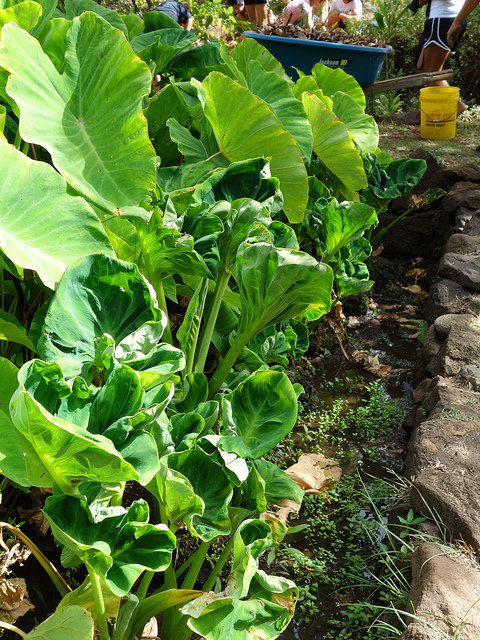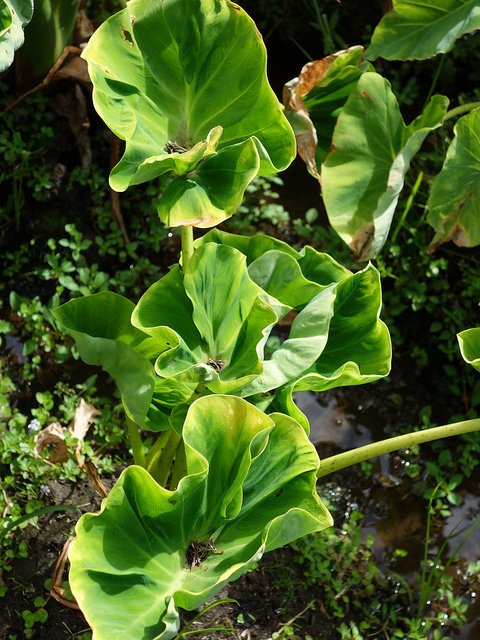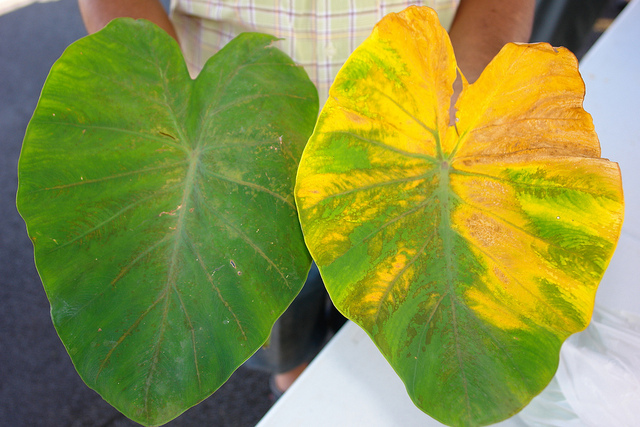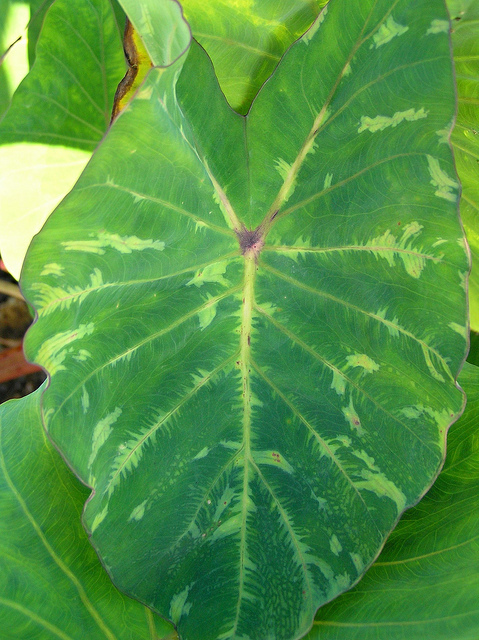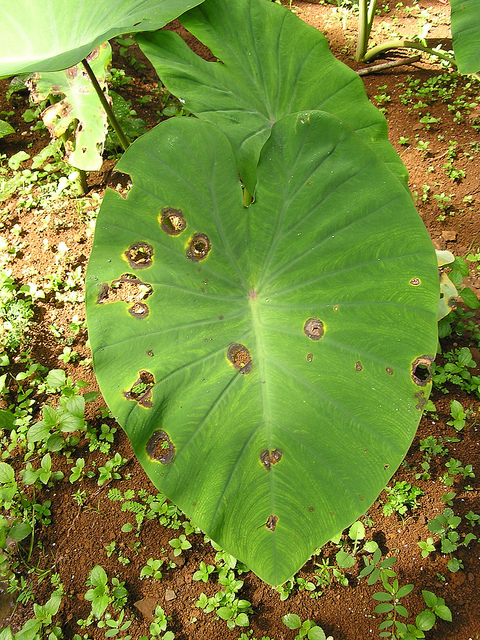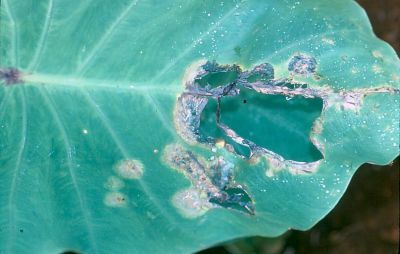This page
is available in French.
Cocoyam
Description
Uses
Propagation
References
Common Pests and Diseases
Diseases
Category : Viral
Alomae-bobone Colocasia bobone disease virus (CBDV)
Symptoms
Leaves thickened, rolled and often brittle; leaf veins are prominent and develop enations; leaf petioles are shortened and also develop enations; plant may recover (bobone disease)
Leaves thickened and dark green in color; distorted areas may develop on leaves and leaves may be cupped (but not rolled as in bobone disease); usually only one to three leaves affected (alomae disease)
Cause
Virus
Comments
Taro plants have been traditionally classified as 'male' or 'female' based on their susceptibility to two diseases, both of which are caused by Colocasia bobone disease virus (CBDV), which are known as bobone and alomae; 'male' plants are susceptible to alomae and die as a result of the infection, but are resistant to bobone; 'female' plants are resistant to alomae but susceptible to bobone from which they recover; the virus is transmitted by leafhoppers
Management
Remove any plants showing symptoms of disease and destroy by burning; removal of outer leaf sheaths may control the disease by reducing the number of leafhopper eggsDasheen mosaic Dasheen mosaic virus (DsMV)
Symptoms
Mosaic pattern on leaves; mild to moderately distorted leaves
Cause
Virus
Comments
Transmitted by aphids; symptoms more pronounced in cooler temperatures; infected plants may show no symptoms of disease fro several months after infection
Management
The best method of control appears to be planting resistant varietiesCategory : Fungal
Phyllosticta leaf spot Phyllosticta colocasiophila
Symptoms
Oval or irregular beige to reddish brown spots on leaves; dark brown spots with chlorotic area around lesion; holes in leaves where lesion centers have dried and dropped out
Cause
Fungus
Comments
Disease emergence favored by cloudy, rainy weather
Management
No control is needed unless the disease is causing severe defoliation of the plants; remove and destroy any diseased leavesCategory : Oomycete
Phytophthora leaf blight Phytophthora colocasiae
Symptoms
Small purple or dark brown, circular, water-soaked lesions on leaves which enlarge, turn purple-brown and may coalesce; lesions may exude clear amber fluid from center; lesions may from concentric pattern and develop white fuzz on both sides of leaves; holes may form in leaves where lesions have dried and dropped out; leaves collapse and die; disease may occur as a post-harvest rot of corms and causes large areas of dark gray to blue rot with indistinct margins
Cause
Oomycete
Comments
Disease emergence favored by rainy overcast weather with low night temperatures; disease spread primarily by splashing rain water
Management
Planting resistant varieties is the most effective method of controlling the disease; if plants do become infected, symptomatic leaves should be removed and destroyed to reduce the level of inoculum; plant cocoyam in well-draining soils; disease may also be controlled by protective sprays of appropriate systemic or non-systemic fungicides where availablePythium root and corm rot Pythium spp.
Symptoms
Soft, mushy rot on corm with foul odor; root system may be completely destroyed; plants stunted with shortened leaf stalks; leaves curled, crinkled and yellowish in color; when corm is cut open rotted area is sharply delineated from healthy tissue
Cause
Fungi
Comments
Disease emergence appears to favor the presence of warm, stagnant water where cocoyam is grown in wetlands; poor field sanitation practices aid in the spread of the disease
Management
Some varieties are more resistant to the disease than others (e.g. Hawaiian varieties Kai Kea and Kai uliuli) and should be planted if disease is known to be a problem in the area; root rot severity can be reduced in acid soils by the addition of the fungicide Captan prior to plantingPests
Category : Insects
Pink hibiscus mealybug Maconellicoccus hirsutus
Symptoms
Stunted growth of plants at growing tips; leaves may be distorted; insects are soft bodied elongated ovals which are pink in color and covered in a white waxy substance; adults are approximately 2-4 mm in length
Cause
Insect
Comments
Pink hibiscus mealybugs have a very wide host range and may also be found on other crops such as cassava and mango as well as leguminous plants
Management
Pesticides are often largely ineffective at controlling the insects as they hide in crevices on the plants and avoid contact with the chemical; in the Caribbean, predatory beetles have been very successful at controlling populations of mealy bugs
Taro beetle
Papuana spp.
Eucopidocaulus spp.
Symptoms
Tunnels bored in corms; tunnels may join together to form large cavities; large populations of insects may bcause the plants to wilt and die; adult insect is a shiny black scarab beetle
Cause
Insect
Comments
Beetle is a major pest of taro in Papua New Guinea and Fiji












